+ Open data
Open data
- Basic information
Basic information
| Entry | Database: PDB / ID: 2l7b | ||||||
|---|---|---|---|---|---|---|---|
| Title | NMR Structure of full length apoE3 | ||||||
 Components Components | Apolipoprotein E | ||||||
 Keywords Keywords | LIPID TRANSPORT / apolipoprotein E / Atherosclerosis / Alzheimer's Disease | ||||||
| Function / homology |  Function and homology information Function and homology informationlipid transport involved in lipid storage / intermediate-density lipoprotein particle clearance / positive regulation of lipid transport across blood-brain barrier / regulation of cellular response to very-low-density lipoprotein particle stimulus / metal chelating activity / triglyceride-rich lipoprotein particle clearance / discoidal high-density lipoprotein particle / lipoprotein particle / negative regulation of triglyceride metabolic process / maintenance of location in cell ...lipid transport involved in lipid storage / intermediate-density lipoprotein particle clearance / positive regulation of lipid transport across blood-brain barrier / regulation of cellular response to very-low-density lipoprotein particle stimulus / metal chelating activity / triglyceride-rich lipoprotein particle clearance / discoidal high-density lipoprotein particle / lipoprotein particle / negative regulation of triglyceride metabolic process / maintenance of location in cell / regulation of amyloid-beta clearance / negative regulation of cholesterol biosynthetic process / positive regulation of lipoprotein transport / Transcriptional regulation by the AP-2 (TFAP2) family of transcription factors / chylomicron remnant clearance / chylomicron remnant / intermediate-density lipoprotein particle / acylglycerol homeostasis / NMDA glutamate receptor clustering / very-low-density lipoprotein particle remodeling / Chylomicron clearance / phosphatidylcholine-sterol O-acyltransferase activator activity / positive regulation of phospholipid efflux / Chylomicron remodeling / lipid transporter activity / positive regulation of low-density lipoprotein particle receptor catabolic process / cellular response to lipoprotein particle stimulus / regulation of protein metabolic process / very-low-density lipoprotein particle clearance / Chylomicron assembly / response to caloric restriction / high-density lipoprotein particle clearance / phospholipid efflux / chylomicron / very-low-density lipoprotein particle receptor binding / regulation of amyloid fibril formation / lipoprotein catabolic process / AMPA glutamate receptor clustering / high-density lipoprotein particle remodeling / positive regulation of cholesterol metabolic process / melanosome organization / regulation of behavioral fear response / multivesicular body, internal vesicle / reverse cholesterol transport / positive regulation of amyloid-beta clearance / high-density lipoprotein particle assembly / host-mediated activation of viral process / low-density lipoprotein particle / lipoprotein biosynthetic process / cholesterol transfer activity / high-density lipoprotein particle / protein import / very-low-density lipoprotein particle / cholesterol catabolic process / heparan sulfate proteoglycan binding / low-density lipoprotein particle remodeling / amyloid precursor protein metabolic process / negative regulation of amyloid fibril formation / positive regulation of membrane protein ectodomain proteolysis / regulation of Cdc42 protein signal transduction / synaptic transmission, cholinergic / regulation of amyloid precursor protein catabolic process / HDL remodeling / negative regulation of endothelial cell migration / cholesterol efflux / regulation of cholesterol metabolic process / artery morphogenesis / negative regulation of protein metabolic process / regulation of axon extension / Scavenging by Class A Receptors / triglyceride homeostasis / triglyceride metabolic process / positive regulation of amyloid fibril formation / low-density lipoprotein particle receptor binding / regulation of innate immune response / virion assembly / negative regulation of endothelial cell proliferation / positive regulation of dendritic spine development / antioxidant activity / response to dietary excess / negative regulation of MAP kinase activity / lipoprotein particle binding / negative regulation of amyloid-beta formation / locomotory exploration behavior / negative regulation of long-term synaptic potentiation / negative regulation of blood vessel endothelial cell migration / negative regulation of platelet activation / negative regulation of blood coagulation / positive regulation of dendritic spine maintenance / positive regulation of endocytosis / regulation of neuronal synaptic plasticity / positive regulation of cholesterol efflux / negative regulation of protein secretion / fatty acid homeostasis / regulation of protein-containing complex assembly / long-term memory / intracellular transport / long-chain fatty acid transport / synaptic cleft / Nuclear signaling by ERBB4 Similarity search - Function | ||||||
| Biological species |  Homo sapiens (human) Homo sapiens (human) | ||||||
| Method | SOLUTION NMR / simulated annealing, distance geometry | ||||||
| Model details | lowest energy, model 1 | ||||||
 Authors Authors | Chen, J. / Wang, J. | ||||||
 Citation Citation |  Journal: Proc.Natl.Acad.Sci.USA / Year: 2011 Journal: Proc.Natl.Acad.Sci.USA / Year: 2011Title: Topology of human apolipoprotein E3 uniquely regulates its diverse biological functions. Authors: Chen, J. / Li, Q. / Wang, J. | ||||||
| History |
|
- Structure visualization
Structure visualization
| Structure viewer | Molecule:  Molmil Molmil Jmol/JSmol Jmol/JSmol |
|---|
- Downloads & links
Downloads & links
- Download
Download
| PDBx/mmCIF format |  2l7b.cif.gz 2l7b.cif.gz | 2.1 MB | Display |  PDBx/mmCIF format PDBx/mmCIF format |
|---|---|---|---|---|
| PDB format |  pdb2l7b.ent.gz pdb2l7b.ent.gz | 1.8 MB | Display |  PDB format PDB format |
| PDBx/mmJSON format |  2l7b.json.gz 2l7b.json.gz | Tree view |  PDBx/mmJSON format PDBx/mmJSON format | |
| Others |  Other downloads Other downloads |
-Validation report
| Summary document |  2l7b_validation.pdf.gz 2l7b_validation.pdf.gz | 412.1 KB | Display |  wwPDB validaton report wwPDB validaton report |
|---|---|---|---|---|
| Full document |  2l7b_full_validation.pdf.gz 2l7b_full_validation.pdf.gz | 659.9 KB | Display | |
| Data in XML |  2l7b_validation.xml.gz 2l7b_validation.xml.gz | 123.5 KB | Display | |
| Data in CIF |  2l7b_validation.cif.gz 2l7b_validation.cif.gz | 152.1 KB | Display | |
| Arichive directory |  https://data.pdbj.org/pub/pdb/validation_reports/l7/2l7b https://data.pdbj.org/pub/pdb/validation_reports/l7/2l7b ftp://data.pdbj.org/pub/pdb/validation_reports/l7/2l7b ftp://data.pdbj.org/pub/pdb/validation_reports/l7/2l7b | HTTPS FTP |
-Related structure data
| Similar structure data | |
|---|---|
| Other databases |
- Links
Links
- Assembly
Assembly
| Deposited unit | 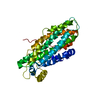
| |||||||||
|---|---|---|---|---|---|---|---|---|---|---|
| 1 |
| |||||||||
| NMR ensembles |
|
- Components
Components
| #1: Protein | Mass: 35301.648 Da / Num. of mol.: 1 Source method: isolated from a genetically manipulated source Source: (gene. exp.)  Homo sapiens (human) / Gene: APOE / Production host: Homo sapiens (human) / Gene: APOE / Production host:  |
|---|
-Experimental details
-Experiment
| Experiment | Method: SOLUTION NMR / Details: NMR structure of full length apoE3 | ||||||||||||||||||||||||||||||||||||||||
|---|---|---|---|---|---|---|---|---|---|---|---|---|---|---|---|---|---|---|---|---|---|---|---|---|---|---|---|---|---|---|---|---|---|---|---|---|---|---|---|---|---|
| NMR experiment |
|
- Sample preparation
Sample preparation
| Details |
| ||||||||||||||||||||||||||||||||||||||||||||
|---|---|---|---|---|---|---|---|---|---|---|---|---|---|---|---|---|---|---|---|---|---|---|---|---|---|---|---|---|---|---|---|---|---|---|---|---|---|---|---|---|---|---|---|---|---|
| Sample |
| ||||||||||||||||||||||||||||||||||||||||||||
| Sample conditions | Ionic strength: 0.1 / pH: 6.9 / Pressure: ambient / Temperature: 303 K |
-NMR measurement
| NMR spectrometer | Type: Varian INOVA / Manufacturer: Varian / Model: INOVA / Field strength: 600 MHz |
|---|
- Processing
Processing
| NMR software |
| ||||||||||||||||||||||||||||||||||||
|---|---|---|---|---|---|---|---|---|---|---|---|---|---|---|---|---|---|---|---|---|---|---|---|---|---|---|---|---|---|---|---|---|---|---|---|---|---|
| Refinement | Method: simulated annealing, distance geometry / Software ordinal: 1 | ||||||||||||||||||||||||||||||||||||
| NMR constraints | Protein chi angle constraints total count: 0 / Protein other angle constraints total count: 0 / Protein phi angle constraints total count: 204 / Protein psi angle constraints total count: 204 | ||||||||||||||||||||||||||||||||||||
| NMR representative | Selection criteria: lowest energy | ||||||||||||||||||||||||||||||||||||
| NMR ensemble | Average torsion angle constraint violation: 0.311 ° Conformer selection criteria: all calculated structures submitted Conformers calculated total number: 20 / Conformers submitted total number: 20 / Maximum lower distance constraint violation: 0 Å / Maximum torsion angle constraint violation: 0.4 ° / Maximum upper distance constraint violation: 0.58 Å / Torsion angle constraint violation method: CYANA | ||||||||||||||||||||||||||||||||||||
| NMR ensemble rms | Distance rms dev: 0.0124 Å / Distance rms dev error: 0.0012 Å |
 Movie
Movie Controller
Controller



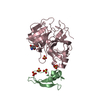




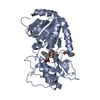
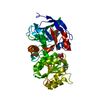


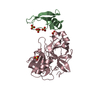
 PDBj
PDBj











 HSQC
HSQC